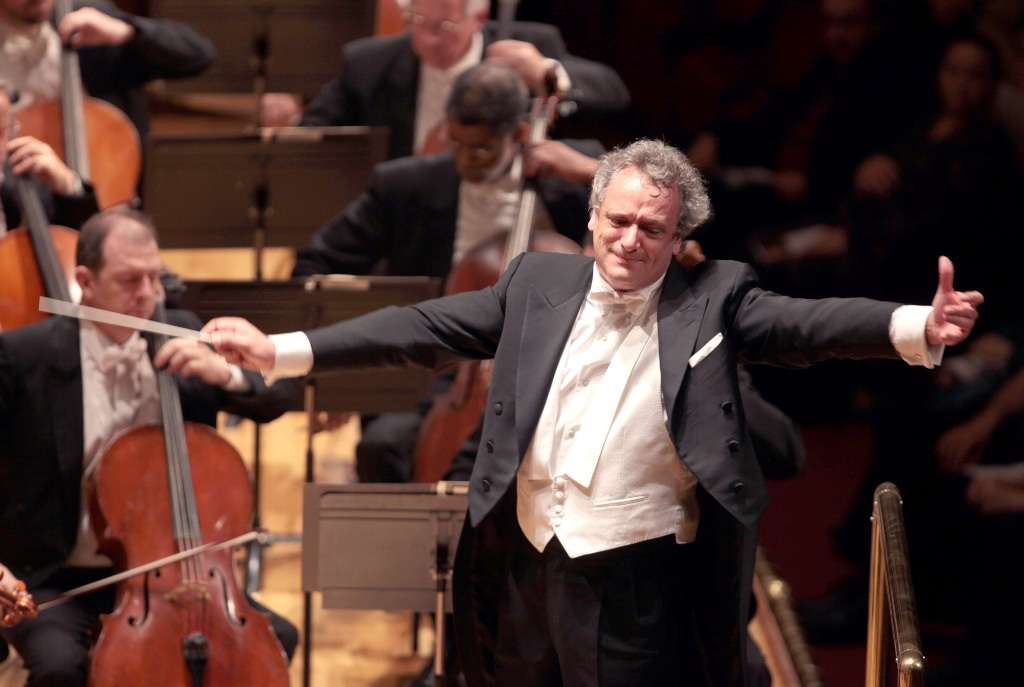|
Back
Langrée Leads Splendid “First” Inaugural with CSO Cincinnati
Music Hall
11/09/2012 - & November 10*, 2012
Olivier Messiaen: Les Offrandes oubliées
Camille Saint-Saëns: Concerto for Piano and Orchestra No. 2 in G Minor, Op. 22
César Franck: Symphony in D Minor
Cédric Tiberghien (piano)
Cincinnati Symphony Orchestra, Louis Langrée (conductor)

L. Langrée (Courtesy of CSO)
French conductor Louis Langrée, appointed music director of the Cincinnati Symphony Orchestra in April, 2012, did not plan an all-French program for his inaugural concert as CSO music director-designate November 9 and 10 at Music Hall.
It just turned out that way. Already a prime candidate to succeed former music director Paavo Järvi, Langrée was engaged for the concert in the fall of 2011. The program’s accent français was entirely fitting, however, and gave the Cincinnati audience a splendid introduction to their new music director, who officially assumes the post next season.
It was a special program in another way, too. Instead of Debussy, Ravel or Berlioz, Langrée chose Franck, Saint-Saëns and Messiaen for the concert. All three composers were organists, and for that reason, “had a sort of spiritual vision of the music,” he said. (This despite the famous observation by pianist/composer Zygmunt Stojowski that Saint-Saëns’ Piano Concerto No. 2 “begins with Bach and ends with Offenbach.”)
Langrée opened on a deeply spiritual note with Messiaen’s Les Offrandes oubliées (“The Forgotten Offerings”). The touching, austere Très lent (representing Christ’s sacrifice on the cross) unfolded freely, to be cut short abruptly by a virtual cannon shot (bass drum), signaling the roiling, savage Vif (human sin), with its searing string harmonics and blistering trumpet calls. The final section (the Eucharist) for nine muted strings floated exquisitely heavenward on soft high harmonics.
Tiberghien, 37, a newcomer to Cincinnati, was the “find” of the evening in Saint-Saëns’ Concerto. His performance of the formidable work was a sensation, the more so for his seeming ease at the task. The tall, lanky Frenchman approached both its technical demands and stylistic variety with great skill, sounding the opening cadenza in lofty tones. He kept the pyrotechnics going throughout the first movement (there is a second cadenza, as well), and moved effortlessly into the tripping, mirthful Allegro scherzando.
The Presto finale, a devilish tarantella with fists full of notes, sealed a demonstration of all-out bravura that Tiberghien’s listeners will not soon forget. Langrée and the CSO were with him every step of the way, and to the delight of the audience, both he and Langrée sat down at the piano to perform the encore, Brahms’ Hungarian Dance No. 11 in D Minor.
Franck’s Symphony in D Minor (making a comeback after years of neglect) was a peak choice for Langrée’s “first” CSO inaugural (he leads two concerts with the orchestra this season before returning in September to begin his four-year tenure). It was a revelation, in fact, both in itself, and as a demonstration of how he and the orchestra relate to one another (Langrée’s other commitments include the Mostly Mozart Festival at New York’s Lincoln Center and the Salzburg Camerata, plus regular engagements at New York’s Metropolitan Opera and the Vienna State Opera).
Langrée led with inspiration and utmost clarity, tracing the lines of the music continuously with his left hand (in addition to dynamics and cues). Conducting from memory, he showed a profound sense of color and texture, drawing out hues and details routinely overlooked or dimmed in other readings. There was obvious joy in the relationship (on both sides), with Langrée often beaming at the players and flinging his arms wide in climactic moments.
Langrée describes the Franck Symphony as a kind of Mass or sacred service, proceeding from darkness to light. The organ-like first movement set the tone, emerging from darkest D Minor to moments tinged with radiance. English hornist Christopher Philpotts shone in the Allegretto, where lines were beautifully shaped, and color and detail carefully noted, to the final, harp-laced, pianissimo chord.
Instant joy broke out in the Allegro finale, which Langrée built to spine-tingling heights. Responding to the ovation that erupted after the final D Major chord, he went into the orchestra, shaking hands with every player he could reach, and hauling everyone to their feet to bask in the applause. Seemingly inexhaustible, he met members of the audience in the Music Hall lobby afterward.
Louis Langrée & Cincinnati Symphony Orchestra
ConcertoNet is on Facebook
Twitter: @concertonet
Mary Ellyn Hutton
|